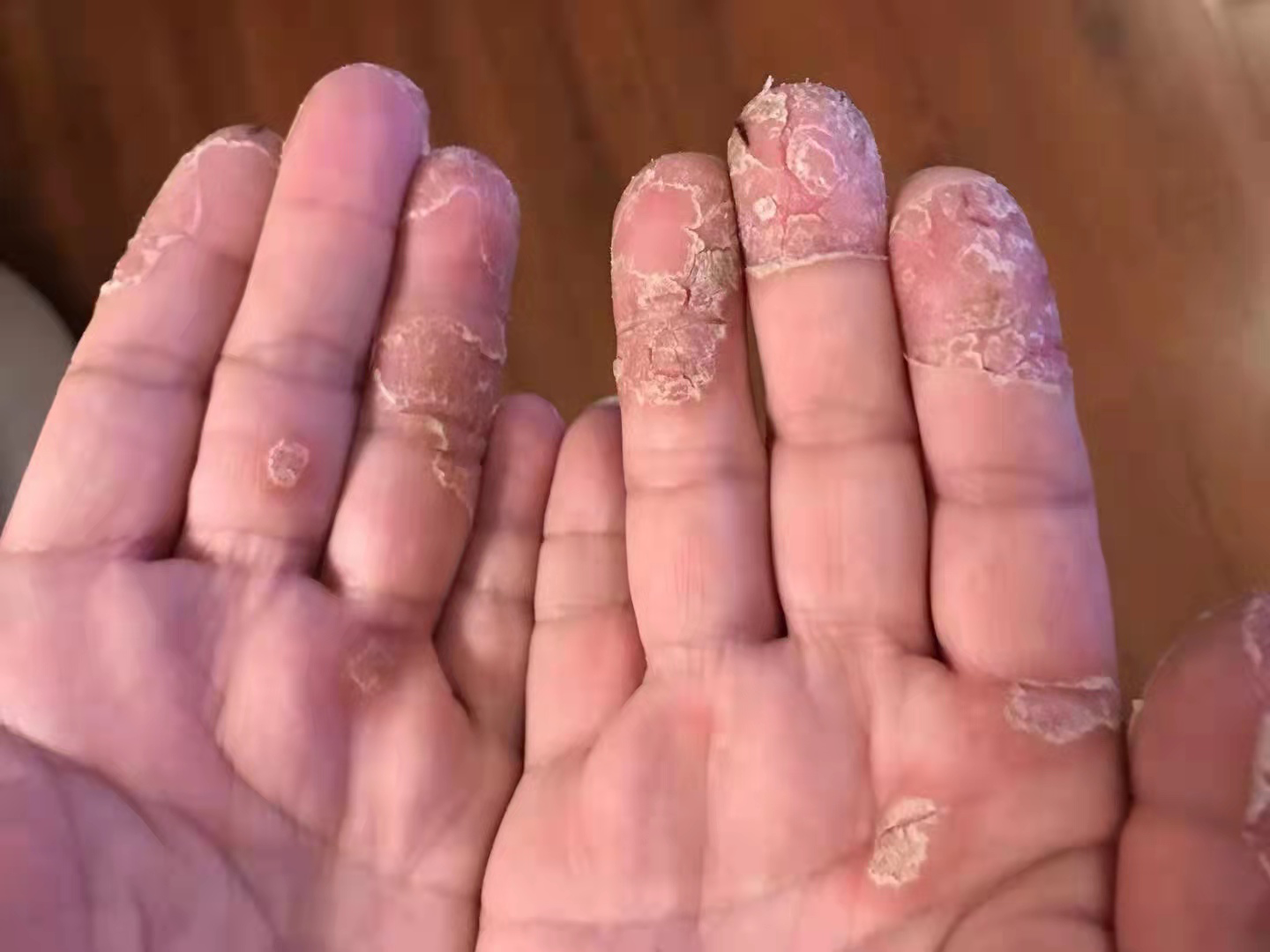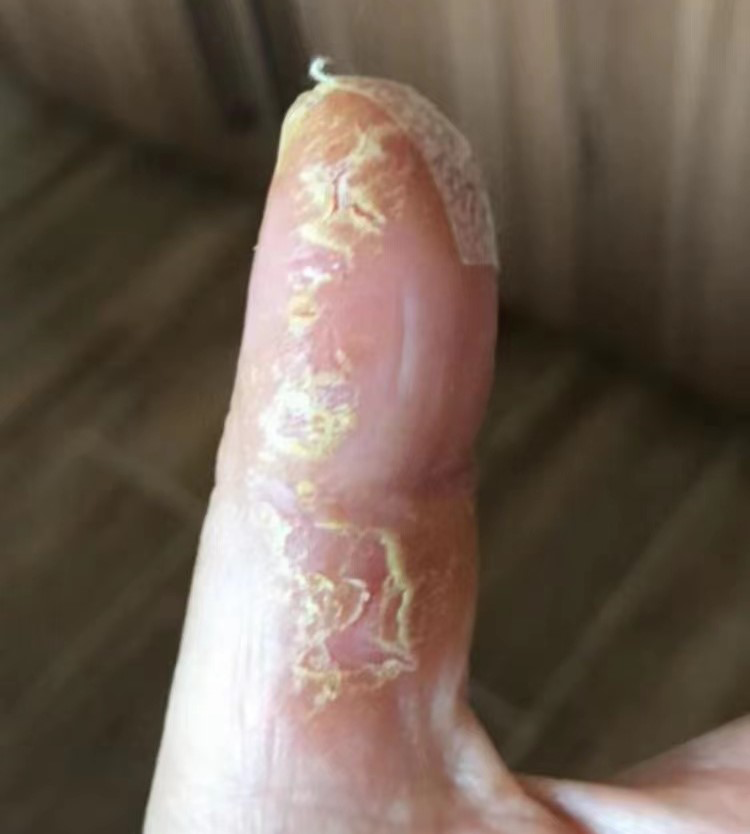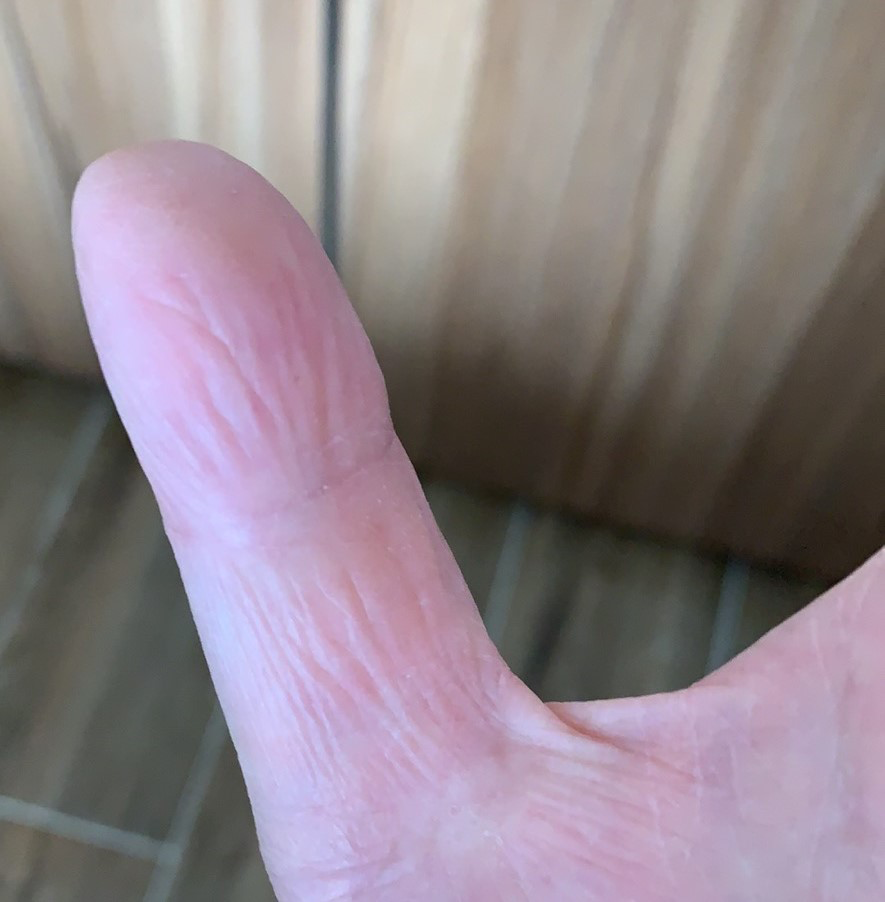Translate this page into:
Dupilumab use in non-atopic chronic hand eczema: Two cases and a review of the literature
Corresponding author: Jianzhong Zhang, Department of Dermatology, Peking University People’s Hospital, Beijing, China. rmzjz@126.com
-
Received: ,
Accepted: ,
How to cite this article: Li T, Li H, Zhang J. Dupilumab use in non-atopic chronic hand eczema: Two cases and a review of the literature. Indian J Dermatol Venereol Leprol 2023;89:877-9.
Sir,
Chronic hand eczema (CHE) is a common inflammatory disease that seriously affects people’s quality of life. Chronic eczema is generally resistant to topical treatment, dupilumab has been found to be effective in few cases of hand eczema with associated atopic dermatitis. We report two cases of non-atopic CHE who are successfully treated with dupilumab.
Case 1: A 57-year-old man presented to the dermatology clinic with a 1-year history of dry, fissured, scaling eruptions on the fingertips and palms, accompanied by minor itching. He had received multiple treatments including potent topical corticosteroids and tacrolimus but with little improvement. On physical examination, his fingertips and palms exhibited dry, fissured and scaly plaques without any vesicles [Figure 1a]. Laboratory studies and the patch test showed no positive results. Due to the absence of a history of allergic disorders, non-atopic hyperkeratotic CHE was diagnosed but the underlying aetiology remained unknown. Traditionally, oral retinoids or immunosuppressive agents are administered when the topical therapy is inadequate. However, given the safety profile, the patient preferred a biological agent so he received a 600 mg injection of dupilumab as a loading dose and 300 mg injection every 2 weeks thereafter. Surprisingly, his persistent lesions improved completely after 3 months [Figure 1b]. The dermatology life quality index score decreased from 11.9 points at baseline to 3.6 points 3 months later. The treatment was well tolerated and no side effect was observed.
Case 2: A 58-year-old woman presented with a 20-year history of progressive desquamative and fissured eruption on her fingertips [Figure 2a], accompanied by minor pain. There were no vesicles and no rashes on any other part of the body. She had received potent corticosteroids and tacrolimus under occlusion but the effect was poor. No allergen was detected through the patch test. Similar to case 1, she had no history of atopy and non-atopic hyperkeratotic CHE was diagnosed. After consulting with the patient, she chose a biological agent over a conventional topical treatment. The treatment of dupilumab was initiated with 600 mg subcutaneously on day 1 followed by 300 mg subcutaneously every 14 days. Her response was so impressive that a 90% improvement was observed in just 2 weeks, and she completely recovered in 6 weeks [Figure 2b]. Six weeks later, the dermatology life quality index score decreased from 10.7 points at baseline to 4.8 points. No adverse events were reported and the response was maintained until the time of writing.

- Case 1 at baseline

- Case 1 after 12 weeks of treatment

- Case 2 at baseline

- Case 2 after 6 weeks of treatment
Dupilumab, a fully human monoclonal antibody that blocks IL-4 and IL-13, is proven for the treatment of atopic dermatitis. CHE is a potential new indication for dupilumab since numerous studies have shown remarkable effects in CHE patients with atopy.1
We found only five previous reports of non-atopic patients with persistent CHE treated with dupilumab [Table 1].2–4 All of the seven cases including ours were treated with dupilumab at standard FDA-approved dosing, and the lesions of six cases were almost cleared in 4–16 weeks. Only one case had little improvement, which may be caused by continuous occupational exposure to irritants and friction. Crepy et al.5 reported a similar case in which an atopic CHE with documented occupational exposure had a poor response to dupilumab.
| Case | Sex, age | Clinical pattern and severity | History of atopy | Patch test | Disease duration | Previous therapy | Response to dupilumab | Adverse events |
|---|---|---|---|---|---|---|---|---|
| Halling et al., 2020 | M, 67 | Vesicular CHE, severe | No | − | 3 years | tCS, Pho, Mtx, Azt, CsA | Almost clear in 4 weeks | N/S |
| Zhu et al., 2020 | M, 43 | Hyperkeratotic CHE, severe | No | − | 5 years | tCS, Pho, alitretinoin, Mtx, CS | Almost clear in 4 weeks | N/S |
| Loman et al., 2021 | M, 65 | Hyperkeratotic CHE, moderate | No | − | 4 years | tCS, Mtx, alitretinoin | Only improvement of itch in 16 weeks | N/S |
| M, 47 | Hyperkeratotic CHE, severe | No | − | 9 years | tCS, Mtx, alitretinoin, CsA | Almost clear in 16 weeks | N/S | |
| F, 65 | Hyperkeratotic CHE, severe | No | − | 4 years | tCS, Azt, alitretinoin | Almost clear in 16 weeks | N/S | |
| Our cases | M, 57 | Hyperkeratotic CHE, severe | No | − | 1 year | tCS, topical tacrolimus | Almost clear in 12 weeks | None |
| F, 58 | Hyperkeratotic CHE, severe | No | − | 20 years | tCS, topical tacrolimus | Almost clear in 6 weeks | None |
tCS, topical corticosteroids; Pho, phototherapy; Mtx, methotrexate; Azt, azathioprine; CsA, cyclosporine; N/S, not significant
In conclusion, we have described two cases that strengthen the evidence that dupilumab’s efficacy in non-atopic CHE is equally promising. In addition, based on the scientific evidence, those with continuous occupational exposure may have a limited response to dupilumab whether they were of atopic or not.
Declaration of patient consent
Patient’s consent not required as patient’s identity is not disclosed or compromised.
Financial support and sponsorship
Nil
Conflicts of interest
There are no conflicts of interest.
References
- The long-term effect of dupilumab on chronic hand eczema in patients with moderate to severe atopic dermatitis—52 week results from the Dutch BioDay Registry. Contact Dermatitis. 2022;87:185-91.
- [CrossRef] [PubMed] [Google Scholar]
- Severe treatment-resistant acute and recurrent vesicular chronic hand eczema successfully treated with dupilumab. Contact Dermatitis. 2020;83:37-8.
- [CrossRef] [PubMed] [Google Scholar]
- Dupilumab for occupational irritant hand dermatitis in a nonatopic individual: A case report. JAAD Case Rep. 2020;6:296-8.
- [CrossRef] [PubMed] [Google Scholar]
- Three cases of non-atopic hyperkeratotic hand eczema treated with dupilumab. Contact Dermatitis. 2021;84:124-7.
- [CrossRef] [PubMed] [Google Scholar]
- Blocking type 2 inflammation by dupilumab does not control classic (type 1-driven) allergic contact dermatitis in chronic hand eczema. Contact Dermatitis. 2019;81:145-7.
- [CrossRef] [PubMed] [Google Scholar]





